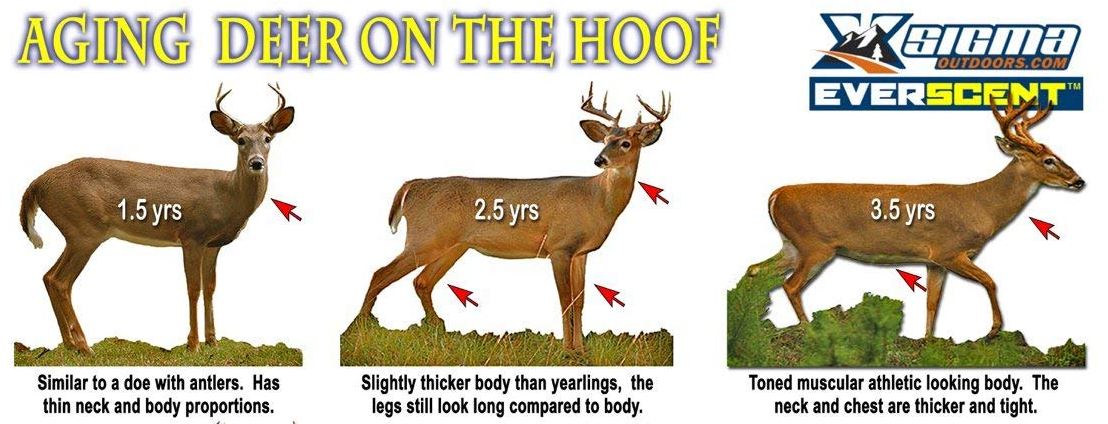12 Tips for Aging Deer on the Hoof
Aging deer on the hoof can be challenging, but there are several key factors and characteristics hunter can look for to make an educated guess about a deer’s age. In this article, we offer 12 tips for aging deer on the hoof. As you would expect, most of the focus is on bucks since hunters and deer managers often practice age-based buck harvest.
Keep in mind that these are general guidelines and individual variations can occur. Some deer are seemingly genetic anomalies and these deer can fool you from time to time. However, these tips for aging deer on the hoof will work on most bucks, and even those that are anomalies. The key is sizing up each of the attributes discussed below so that each deer you age becomes the sum of its collective attributes.

Go-To Tips for Aging Deer
- Body Size: Younger deer tend to be smaller in size, while older deer are generally larger and more robust. Look at the overall body size and proportions of the deer.
- Body Shape: Younger deer often have a sleeker and more streamlined body shape. Legs appear long on young deer. Older deer may show signs of a more barrel-chested or sagging belly. Legs look short on dee-bodied bucks.
- Face and Neck: Pay attention to the deer’s face and neck. Older bucks tend to have a more pronounced neck during the rut, while younger bucks have a smoother transition from head to neck. The necks of younger bucks looks more like that of does.
- Antler Development: Antlers can provide important clues. Bucks typically start growing antlers at around one year of age, but the size and structure of the antlers do change as the deer gets older. Older bucks generally have thicker antlers with more tines and greater mass. Of all characteristics, mass is generally the most telling, as mass increases with age.
- Tine Length: The length of tines on a buck’s antlers can also indicate age. Older bucks tend to have longer tines, while younger bucks may have shorter, less developed tines. The caveat is that tine length in really old bucks will decrease. However, most of the characteristics described above should apply.
- Main Beam Length: The overall length of the main beam of the antlers can give you an idea of age. Older bucks often have longer main beams compared to younger ones.
- Antler Spread: Antler spread can be an indicator of age, but it’s not always reliable. Some younger bucks might have relatively wide spreads, and older bucks might have narrower spreads due to genetics or other factors. Evaluate antler mass to confirm.
- Antler Configuration: Older bucks tend to have more complex and irregular antler configurations with additional points and unique features.
- Face Grayness: Older deer, especially bucks, might show signs of graying around the face, muzzle, and sometimes the body. Like humans, changes in hair color occur with age.
- Belly Sway: As deer age, their bellies might appear to sag or sway more noticeably, especially in older bucks and does.
- Movement: Older deer often move more confidently and deliberately, while younger deer might exhibit more skittish behavior. Young deer tend to move out of the way when larger, more mature bucks enter an area.
- Behavior: Older deer tend to be more cautious and exhibit patterns of behavior that show they have learned to avoid danger over time. Younger bucks are less weary, while older bucks hang back until they deem the area safe.

Tips for Aging Deer in the Field or from Photos
Remember that these are general guidelines and that factors such as genetics, nutrition, and environment can influence a deer’s appearance and characteristics. It’s also important to note that accurately aging deer on the hoof can be challenging, especially from a distance. We recommend scouting the area you hunt with game cameras. Ideally, cameras allow you to collect several photos a specific buck, and at different angles, so that you have the best opportunity to age in correctly.
Aging Deer: Continued Education
If you’re serious about determining the age of deer in your area, consider consulting with local wildlife biologists or experienced hunters who are familiar with the specific deer population in your region. It never hurts to ask for help. Then, you can pair these 12 tips for aging deer on the hoof with any details they provide to you. Aging deer is definitely challenging but information is much like buck photos — the more you have the better!